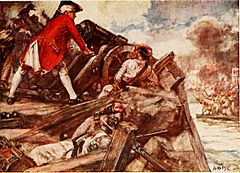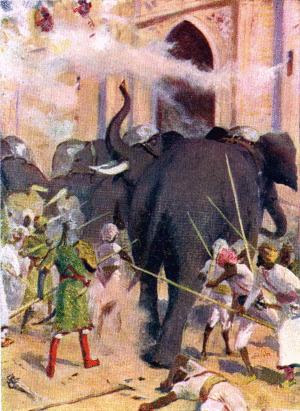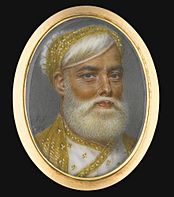Siege of Arcot facts for kids
Quick facts for kids Siege of Arcot |
|||||||
|---|---|---|---|---|---|---|---|
| Part of the Second Carnatic War | |||||||
 Robert Clive fires a cannon in the siege of Arcot |
|||||||
|
|||||||
| Belligerents | |||||||
|
|
|
||||||
| Commanders and leaders | |||||||
| Strength | |||||||
|
600 Carnatic Troops |
5,000 Carnatic Troops |
||||||
The Siege of Arcot was a major battle that happened in Arcot, India. It took place from September 23 to November 14, 1751. This fight was part of a bigger conflict called the Second Carnatic War. It involved the British East India Company and their ally, Muhammad Ali Khan Wallajah. They fought against Chanda Sahib, who was the local ruler, and his allies from the French East India Company.
Contents
Why Did the Siege of Arcot Happen?
In the 1700s, the powerful Mughal Empire in India was getting weaker. This meant that many smaller kingdoms and rulers, called Nawabs, became more independent. At the same time, the British and French East India Companies were doing a lot of trade in India. They had trading posts and ports in places like Calcutta, Madras, and Pondicherry.
European Rivalry in India
Both the British and French wanted more influence in India. They started making deals with local rulers. These deals were mainly for trade, but also to gain control over land and taxes. Since Britain and France were rivals in Europe, they brought their competition to India. They began supporting different Indian rulers who were fighting for power. The Indian princes liked the money from trade. But they especially wanted the military help that the Europeans could offer. This help could give them an advantage over their rivals.
The Fight for Control
When the ruler of a large area called the Deccan died in 1748, both the British and French supported different people to take his place. The French-backed candidate won. Then, there was another fight for who would rule the Carnatic region, which was part of the Deccan. The French supported Chanda Sahib to become the Nawab of Arcot. This meant that the British trading post in Madras was surrounded by areas controlled by their enemies.
Chanda Sahib, after taking control of Arcot, wanted to defeat his last main rival, Muhammed Ali Khan Wallajah. Wallajah was hiding in a city called Trichinopoly. Chanda Sahib led a large army to attack Trichinopoly. Wallajah was only supported by a few of his own men and about 600 British soldiers. The British leaders in other parts of India almost gave up on Trichinopoly. They thought the French would soon control all of southern India.
Clive's Bold Plan
Robert Clive, who used to be a clerk for the British East India Company, was upset by how weak the British response was. He came up with a daring plan. Instead of fighting the strong French and Indian forces at Trichinopoly, he suggested attacking Arcot. Arcot was Chanda Sahib's capital city. Clive hoped this would force Chanda Sahib to stop his attack on Trichinopoly.
The governor in Madras, Thomas Saunders, agreed to Clive's plan. But he could only give Clive 200 of his 350 British soldiers. These 200 soldiers, along with 300 Indian soldiers (called sepoys), 3 small cannons, and 8 European officers, marched towards Arcot. They left Madras on August 26, 1751.
Taking Arcot Without a Fight
Clive's forces marched quickly. They even faced a huge thunderstorm. When they reached Arcot, the soldiers guarding the city were scared. Even though they had more men, they left the fort without a fight. Clive and his men took over the city and the fort without firing a single shot.
When Chanda Sahib heard that Arcot was lost, he immediately sent 4,000 of his best soldiers. He also sent 150 French soldiers, led by his son, Raza Sahib. Their mission was to take Arcot back. On September 23, Raza Sahib entered the town. He surrounded the fort with a huge army. This army included 2,000 regular Indian troops, 5,000 irregular fighters, 120 Europeans, and 300 cavalry (soldiers on horseback).
Preparing for the Siege
Arcot was a city of 100,000 people. Clive quickly gained control by making sure his soldiers did not loot. He also gave back property that Chanda Sahib had taken from its owners. Clive immediately started gathering food and water. He also worked on making the city's defenses stronger.
Challenges Inside the Fort
The fort only had enough food for sixty days. But there was plenty of water. The fort walls were about a mile long, but they were not very strong. Some of the towers were falling apart and could not be used for cannons. The moat around the fort was dry in many places. Clive's force had also become smaller due to sickness and injuries. He now had only 120 Europeans and 200 sepoys.
Chanda Sahib's army camped a few miles away. They blocked any new supplies or soldiers from reaching Clive. Clive tried to attack them twice, but failed. So, he decided on a surprise night attack on September 14. This attack was so successful that the enemy scattered in fear. Clive's men did not suffer any injuries.
Two days later, Clive heard that Governor Saunders had sent two large cannons. Clive sent almost all his soldiers to bring these cannons safely to the city. The few soldiers who stayed behind managed to fight off two night attacks. They used the darkness to hide how few they were.
The Siege Begins
Clive and his men stayed inside the fort in the city center. Raza Sahib's troops took over taller buildings that looked down on the fort walls. Clive tried to attack them to push them away. But he faced heavy gunfire from the newly occupied buildings. His attack did manage to kill most of the French artillerymen. However, he lost fifteen of his British soldiers.
Life Inside the Fort
The defenders were completely surrounded and soon began to suffer. They were cut off from outside water. The fort's own water supply was salty. Luckily, food was not a problem yet. The enemy soldiers, who were in the nearby houses, shot at anyone who moved. Clive's small group of defenders became very tired trying to guard the fort walls all the time.
The Indian soldiers showed great courage and energy during the defense. They even suggested that all the stored grain should be saved for the European soldiers. They believed the Europeans needed more food than Asians. For themselves, they said the water used to cook rice would be enough.
Waiting for Help
Back in Madras, Governor Saunders managed to gather a few more soldiers. He also received some new recruits from England. In late October, a small force of 130 British and 100 sepoys finally set out to help Clive. But this relief force was stopped by the enemy and forced to turn back.
Later in October, some heavy cannons arrived from the French base at Pondicherry. They were set up northwest of Clive's position. These cannons quickly destroyed one of Clive's large cannons and damaged another. For six days, the French pounded the walls. They destroyed a section of the wall between two old towers. The British tried to fill the gap with trenches, wooden fences, and piles of rubble. Another set of cannons was placed to the southwest, creating another hole in the wall.
The siege went on and on. Food and ammunition were almost gone. After fifty days, Clive's only hope was help from a Maratha chief named Morari Rao. Morari Rao had stayed neutral until then. But he was impressed by the British determination and promised to help them.
A Refusal to Surrender
As the Maratha commander, Morari Rao, was getting ready to join the fight, Raza Sahib learned about the new threat. He quickly offered Clive good surrender terms and a gift if he would give up. But Clive knew the Marathas were coming and that another force was on its way from Madras. So, he refused.
Then Raza Sahib sent a message saying he would storm the fort immediately. He threatened to kill every defender. Clive calmly replied that Raza Sahib's father was a usurper (someone who took power illegally). He also said Raza Sahib's army was a disorganized crowd. Clive told him to think twice before sending such cowards into a breach defended by English soldiers.
The Final Battle

Raza Sahib decided to launch a final attack. He chose November 14, a day when a big Muslim festival called Moharram is celebrated. But on November 13, a spy warned Clive about the coming attack.
The enemy advanced, pushing elephants in front of them. These elephants had iron plates on their foreheads. Raza Sahib hoped the elephants would break down the fort gates. But as soon as the huge animals felt the English musket-balls, they turned around. They ran away furiously, trampling the very soldiers who had pushed them forward.
A raft was launched onto the water that filled one part of the ditch. Clive saw that the gunners at that spot were not doing well. So, he took control of a cannon himself. He cleared the raft of enemies in just a few minutes.
Where the moat was dry, the attackers climbed with great bravery. But the British fired heavily and accurately. The attackers could not make any progress. The soldiers in the back rows of the British force kept giving loaded muskets to the front rows. Every shot hit the large group of enemies below. After these desperate attacks, the attackers retreated behind the ditch.
The fight lasted about an hour. Four hundred of the attackers were killed. The defenders, however, lost only five or six men. The besieged soldiers spent an anxious night, expecting the attack to start again. But when day broke, the enemy was gone. Under the cover of fire, Raza Sahib had given up the siege. He had taken his army to Vellore, leaving behind several cannons and a lot of ammunition.
What Happened Next?
Clive's small force had achieved an amazing victory against overwhelming odds. But in India, having more soldiers was not always the most important thing. The death of the enemy's attack commander during the final charge broke his army's spirit.
No matter what combination of events led to Clive's victory, the Siege of Arcot changed everything for the British in India. Clive's biographer, Mark Bence-Jones, wrote that it created a legend of English courage and strength. This legend would lead to many more British successes in India.
Many people in southern India, including some of the soldiers who had attacked Arcot, joined the British company's army. The British began to seriously recruit and train men from the armies and areas they conquered. This led to a top-notch army of sepoys, mixed with a few British Army units sent to India. France lost its dreams of a colonial empire in India. Their bad luck in India got even worse a few years later during the Seven Years' War.



